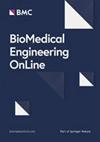A multi-task learning model using RR intervals and respiratory effort to assess sleep disordered breathing
IF 2.9
4区 医学
Q3 ENGINEERING, BIOMEDICAL
引用次数: 0
Abstract
Sleep-disordered breathing (SDB) affects a significant portion of the population. As such, there is a need for accessible and affordable assessment methods for diagnosis but also case-finding and long-term follow-up. Research has focused on exploiting cardiac and respiratory signals to extract proxy measures for sleep combined with SDB event detection. We introduce a novel multi-task model combining cardiac activity and respiratory effort to perform sleep–wake classification and SDB event detection in order to automatically estimate the apnea–hypopnea index (AHI) as severity indicator. The proposed multi-task model utilized both convolutional and recurrent neural networks and was formed by a shared part for common feature extraction, a task-specific part for sleep–wake classification, and a task-specific part for SDB event detection. The model was trained with RR intervals derived from electrocardiogram and respiratory effort signals. To assess performance, overnight polysomnography (PSG) recordings from 198 patients with varying degree of SDB were included, with manually annotated sleep stages and SDB events. We achieved a Cohen’s kappa of 0.70 in the sleep–wake classification task, corresponding to a Spearman’s correlation coefficient (R) of 0.830 between the estimated total sleep time (TST) and the TST obtained from PSG-based sleep scoring. Combining the sleep–wake classification and SDB detection results of the multi-task model, we obtained an R of 0.891 between the estimated and the reference AHI. For severity classification of SBD groups based on AHI, a Cohen’s kappa of 0.58 was achieved. The multi-task model performed better than a single-task model proposed in a previous study for AHI estimation, in particular for patients with a lower sleep efficiency (R of 0.861 with the multi-task model and R of 0.746 with single-task model with subjects having sleep efficiency < 60%). Assisted with automatic sleep–wake classification, our multi-task model demonstrated proficiency in estimating AHI and assessing SDB severity based on AHI in a fully automatic manner using RR intervals and respiratory effort. This shows the potential for improving SDB screening with unobtrusive sensors also for subjects with low sleep efficiency without adding additional sensors for sleep–wake detection.利用 RR 间期和呼吸强度评估睡眠呼吸紊乱的多任务学习模型
睡眠呼吸障碍(SDB)影响着很大一部分人口。因此,不仅需要方便易用、经济实惠的评估方法来诊断,还需要病例发现和长期跟踪。研究重点是利用心脏和呼吸信号提取睡眠的替代测量值,并结合 SDB 事件检测。我们介绍了一种新颖的多任务模型,该模型结合了心脏活动和呼吸努力来执行睡眠-觉醒分类和 SDB 事件检测,从而自动估算作为严重程度指标的呼吸暂停-低通气指数(AHI)。所提出的多任务模型利用了卷积神经网络和递归神经网络,由用于普通特征提取的共享部分、用于睡眠-觉醒分类的特定任务部分和用于 SDB 事件检测的特定任务部分组成。该模型使用心电图和呼吸努力信号中的 RR 间期进行训练。为了评估该模型的性能,我们采用了 198 名不同程度的 SDB 患者的夜间多导睡眠图(PSG)记录,并人工标注了睡眠阶段和 SDB 事件。在睡眠-觉醒分类任务中,我们取得了 0.70 的科恩卡帕(Cohen's kappa),这与估计的总睡眠时间(TST)和基于 PSG 的睡眠评分所获得的总睡眠时间(TST)之间的斯皮尔曼相关系数(R)为 0.830 相对应。结合多任务模型的睡眠-觉醒分类和 SDB 检测结果,我们得出估计 AHI 与参考 AHI 之间的 R 值为 0.891。根据 AHI 对 SBD 组别进行严重程度分类时,科恩卡帕(Cohen's kappa)值为 0.58。在 AHI 估算方面,多任务模型的表现优于之前研究中提出的单任务模型,尤其是对于睡眠效率较低的患者(对于睡眠效率低于 60% 的受试者,多任务模型的 R 值为 0.861,单任务模型的 R 值为 0.746)。在自动睡眠-觉醒分类的辅助下,我们的多任务模型证明了其在估算 AHI 和根据 AHI 评估 SDB 严重程度方面的能力,该方法是全自动的,使用的是 RR 间期和呼吸强度。这表明,在不增加额外的睡眠-觉醒检测传感器的情况下,使用非侵入式传感器对低睡眠效率的受试者进行 SDB 筛查也有改进的潜力。
本文章由计算机程序翻译,如有差异,请以英文原文为准。
求助全文
约1分钟内获得全文
求助全文
来源期刊

BioMedical Engineering OnLine
工程技术-工程:生物医学
CiteScore
6.70
自引率
2.60%
发文量
79
审稿时长
1 months
期刊介绍:
BioMedical Engineering OnLine is an open access, peer-reviewed journal that is dedicated to publishing research in all areas of biomedical engineering.
BioMedical Engineering OnLine is aimed at readers and authors throughout the world, with an interest in using tools of the physical and data sciences and techniques in engineering to understand and solve problems in the biological and medical sciences. Topical areas include, but are not limited to:
Bioinformatics-
Bioinstrumentation-
Biomechanics-
Biomedical Devices & Instrumentation-
Biomedical Signal Processing-
Healthcare Information Systems-
Human Dynamics-
Neural Engineering-
Rehabilitation Engineering-
Biomaterials-
Biomedical Imaging & Image Processing-
BioMEMS and On-Chip Devices-
Bio-Micro/Nano Technologies-
Biomolecular Engineering-
Biosensors-
Cardiovascular Systems Engineering-
Cellular Engineering-
Clinical Engineering-
Computational Biology-
Drug Delivery Technologies-
Modeling Methodologies-
Nanomaterials and Nanotechnology in Biomedicine-
Respiratory Systems Engineering-
Robotics in Medicine-
Systems and Synthetic Biology-
Systems Biology-
Telemedicine/Smartphone Applications in Medicine-
Therapeutic Systems, Devices and Technologies-
Tissue Engineering
 求助内容:
求助内容: 应助结果提醒方式:
应助结果提醒方式:


